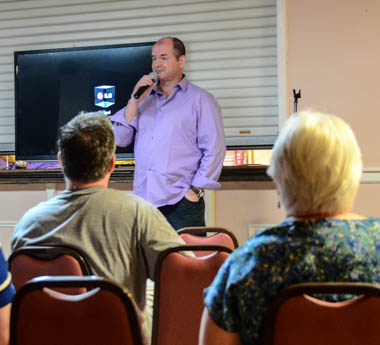Most people are content to write their family history or fill in branches on a family tree template. Alan Brown turned his into a film.
“The Minnits of Anabeg” tells the story of an English Protestant justice of the peace, owner of 1,000 acres in Nenagh, County Tipperary, who worked to save the people in his community from the ravages of what’s come to be known as the Great Famine during which a million Irish died and the same number emigrated.
That man was Brown’s great-great-great grandfather. The movie, which Brown made though his London-based company, Krown Films, was shown on Tuesday at the Irish Center. Brown, who wrote and directed the film, was on hand to answer questions.
The film uses the device of a writer digging into the past to introduce Brown’s ancestor Joshua Minnit who interceded with the British government to help reduce the amount of food taken from Ireland to feed British forces abroad. That allowed Brown to introduce the word “genocide” into the film—a more modern view of a famine caused not by a lack of food, but by the failure of one crop, a certain kind of potato, that was the staple of the lower classes in a country otherwise rich with food and livestock.
Minnitt’s son Robert, who fell in love with a local Catholic girl (whom he later married over his parents’ objections), took his support of his neighbors even further—telling a local Catholic publication about the horrors of the workhouses, where families were split up, men set to breaking stone for roads and women washing laundry, and children taken from their mothers if they were older than two and trained for domestic service.
The workhouses were overcrowded and many people, starving and desperate, clamored to get in anyway. Many of them died there, said the film’s associate producer, Ciara O’Sullivan, who also played a role in the film. Concurrent with the famine was a cholera epidemic.
Brown’s grandfather, he told the crowd at The Irish Center, was Jim Minnitt, son of Joshua’s son, Robert. Jim Minnit himself helped the republican cause in the 20s and 30s by helping wanted rebels escape from British hands. Jim, an auto mechanic, had one of the few cars in the area.
After his marriage, Robert Minnitt was given a small house on the outskirts of his father’s home and lived out the rest of his life with his wife, Eileen Kennedy, and their 13 children, serving as the town postman. He never spoke to his father again and Jim Minnitt never really knew his grandparents.
Brown wasn’t the only one in attendance whose family history was shown on the screen Tuesday night. Also in the audience was Brendan O’Connell of Newtown Square, his son, Ryan, his mother Georgina, and sister Deirdre O’Connell of Flourtown. The O’Connells are descended from Jim Minnitt’s sister—Robert Minnit’s daughter.
“We only worked it out in the last couple of years,” said Brendan. “My brother keeps up with the local Nenagh news and he saw that the film was being made. I emailed Alan in Ireland and we figured out how we were connected.”
Several Tipperary natives also attended the screening. Sisters Sarah Walsh and Mary Brennan both emigrated from an area near Nenagh along with their sister, Kathleen. They remembered the Minnits’ home, Anabeg. “The house is still there,” said Sarah Walsh. “My sister lives nearby. And my brother used to work at Minnitt’s garage.”
Brown has been showing his film in the US to Irish audiences like those at The Irish Center after debuting it in Nenagh on July 26.
To see other photos from the evening, including one of the “Minnit cousins,” click here.

